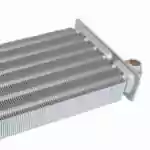The primary heat exchanger in a gas boiler is a crucial part of the combustion chamber and is responsible for collecting the heat produced by combustion. Regular boiler maintenance typically involves cleaning the primary heat exchanger to remove oxides that have formed during the boiler's operation. There are various designs of the primary heat exchanger based on the type of generator: cast exchangers, horizontal, multi-plane, cylindrical.
In condensing boilers, the heat exchanger is sealed and includes a condensate collection tray, where the combustion products are separated. The materials used in condensing boilers include stainless steel, aluminum, or aluminum/silicon alloys.
In lower-efficiency boilers, the primary heat exchanger facilitates the passage of flue gases, with a lamellar exchange surface, typically made of copper, to optimize heat transfer.
Primary Heat Exchanger in Low-Efficiency Boilers
The primary heat exchanger in low-efficiency boilers is designed to facilitate the passage of flue gases and heat collection. The technical water, acting as a vector fluid, encounters resistances that decrease its flow, allowing for cooling. The flow of the circulator (pump) is slightly reduced by the use of spiral fins that alter the fluid dynamics of the technical water.
The boiler's main control board monitors the temperatures via the supply sensor to prevent state change, reducing the risk of noises due to boiling or overheating, often caused by sludge from the heating system.
Overheating of the technical water can lead to leaks in the heating system safety valve, joint seals, or the primary heat exchanger itself.
Primary Heat Exchanger in Condensing Boilers
The primary heat exchanger is a key component in gas and condensing boilers, significantly contributing to the heating system's efficiency. This vital part absorbs the heat generated by combustion and transfers it to the heating water, which is then distributed through the building's heating system.
Moreover, the primary heat exchanger in condensing boilers is designed to collect the condensate water produced from gas combustion, a crucial aspect for maintaining energy efficiency and reducing emissions.
Common Issues
Boiler Making a Frying Noise
This could be related to the primary heat exchanger; noises resembling frying are linked to the boiling point of the technical water. Often, dirt from radiators can clog the passages in this exchanger, causing noise due to the state change to steam.
An obstruction in the primary heat exchanger could trigger the overtemperature sensor, causing the boiler to lock. It is crucial to contact a specialized technician for maintenance and cleaning.
Boiler Making Repetitive Rhythmic Noises
Not to be confused with noises from the gas valve. Due to the evaporation of technical water, this could lead to high-frequency rhythmic percussions. Turn everything off and contact your trusted technician for an inspection.
